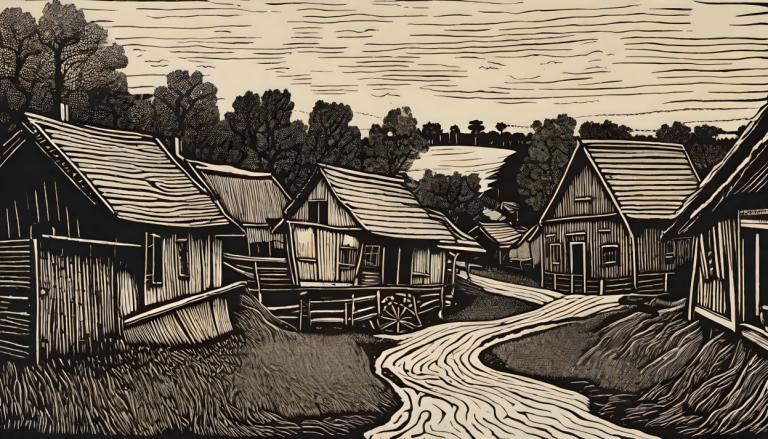The Importance of Agriculture to Village Survival
Agriculture is the cornerstone of life in many villages around the world. It provides the primary source of food, income, and employment for the majority of rural populations. The productivity of agricultural practices directly influences the well-being and sustainability of village communities. Villagers often rely on a mix of crop farming, animal husbandry, and sometimes fishing to meet their dietary needs and generate income. The success of agricultural activities impacts the ability to build and maintain infrastructure, such as schools, clinics, and roads, thereby enhancing the overall quality of life in the village. Furthermore, agriculture fosters a deep connection to the land and environment, which is integral to the cultural identity and heritage of rural communities.
The Transition from Subsistence Farming to Commercial Agriculture
Historically, many villages practiced subsistence farming, where the primary aim was to produce enough food to meet the immediate needs of the community. However, over time, there has been a gradual shift towards commercial agriculture. This transition involves producing crops and livestock for sale in local, regional, and even international markets. The shift to commercial agriculture can lead to increased income and economic development, allowing villagers to invest in better infrastructure, education, and healthcare. However, it also presents challenges, such as the need for improved agricultural techniques, access to markets, and the risk of market fluctuations. Balancing subsistence and commercial farming is crucial for ensuring food security and economic stability in villages.
Crop Diversity and Its Role in Village Economies
Crop diversity plays a vital role in the economic resilience and sustainability of village economies. Growing a variety of crops can enhance soil health, reduce the risk of pest and disease outbreaks, and provide a buffer against market volatility. Diverse cropping systems can include staple foods, cash crops, and plants with medicinal or cultural significance. Crop diversity also supports local food systems by ensuring a year-round supply of nutritious food, reducing the need for external food sources. Additionally, diverse crops can be processed into value-added products, creating new income streams for villagers. By maintaining crop diversity, villages can build more resilient and adaptable agricultural systems that support both ecological health and economic prosperity.
The Challenges of Modern Farming Techniques in Rural Areas
While modern farming techniques offer opportunities for increased productivity and efficiency, they also present challenges for rural areas. The adoption of mechanization, chemical fertilizers, and pesticides can lead to environmental degradation, such as soil erosion, water pollution, and loss of biodiversity. Additionally, the high costs of modern agricultural inputs can be prohibitive for small-scale farmers, limiting their ability to compete with larger agribusinesses. There is also the risk of dependency on external technologies and markets, which can make rural economies vulnerable to global economic fluctuations. To address these challenges, it is essential to promote sustainable farming practices that balance productivity with environmental stewardship and social equity.
Organic Farming and Sustainability in Villages
Organic farming offers a sustainable alternative to conventional agricultural practices, emphasizing the use of natural inputs and ecological processes. By avoiding synthetic chemicals and genetically modified organisms, organic farming helps preserve soil health, water quality, and biodiversity. Villages that adopt organic farming methods can benefit from healthier food, reduced environmental impact, and potential premium prices for organic products. Additionally, organic farming practices often align with traditional knowledge and cultural practices, making them more accessible and acceptable to rural communities. Promoting organic farming in villages can enhance food security, improve livelihoods, and contribute to the overall sustainability of rural areas.
The Future of Farming in Villages: Innovation and Tradition
The future of farming in villages lies in the integration of innovation and tradition. Technological advancements, such as precision agriculture, renewable energy, and digital tools, offer new opportunities for improving agricultural productivity and resilience. For example, precision farming techniques can optimize the use of water, fertilizers, and pesticides, reducing waste and environmental impact. Renewable energy sources, such as solar and wind power, can provide affordable and sustainable energy for agricultural operations. Digital tools, such as mobile apps and online platforms, can facilitate access to market information, agricultural extension services, and financial resources. However, it is essential to combine these innovations with traditional knowledge and practices that have sustained rural communities for generations. By embracing both innovation and tradition, villages can build resilient and sustainable agricultural systems that support their long-term development.
Villages and agriculture are deeply intertwined, with farming practices shaping the economic, social, and cultural fabric of rural communities. From the importance of subsistence farming to the potential of commercial agriculture, crop diversity, and organic farming, the agricultural sector plays a crucial role in village survival and prosperity. The challenges of modern farming techniques and the opportunities for innovation and sustainability highlight the need for a balanced approach that respects traditional knowledge while embracing new technologies. By supporting resilient and sustainable agricultural practices, villages can ensure their continued growth and development in the face of changing economic and environmental conditions.












